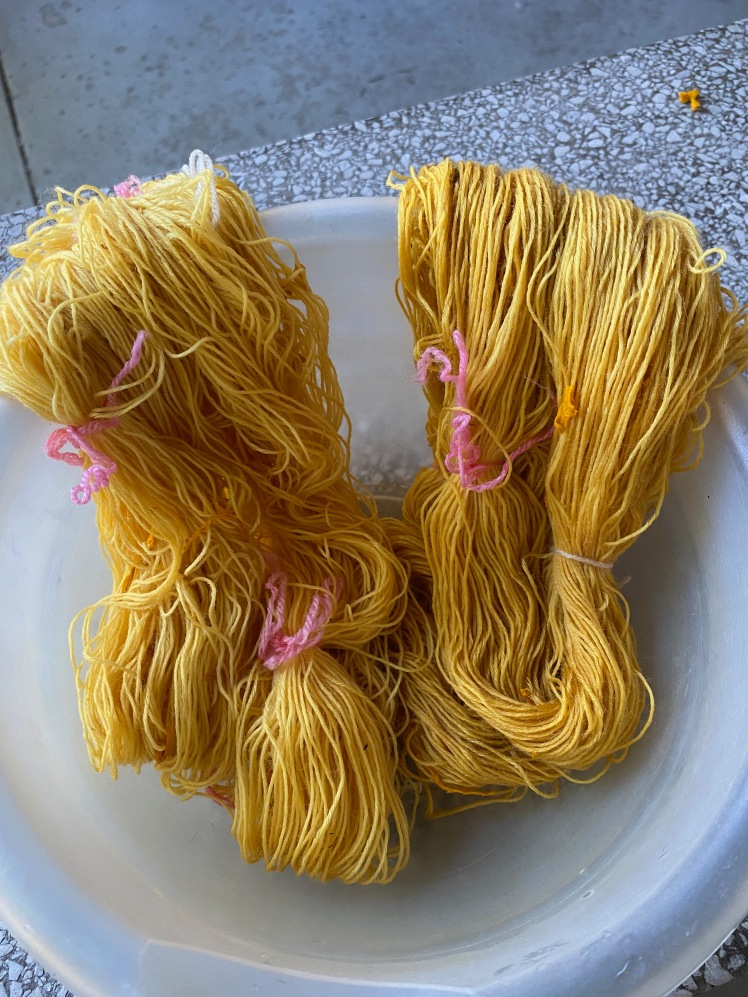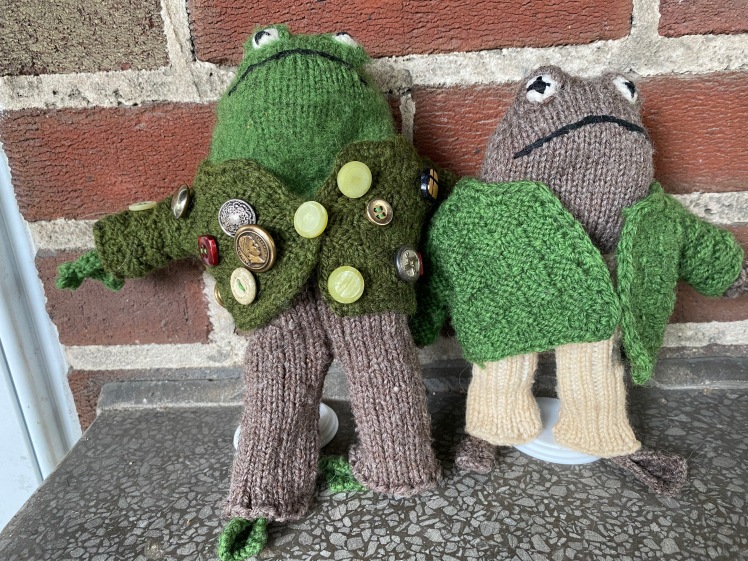For my first couple of years of dyeing yarn using foraged local plant materials, a good true orange was the color I craved and never achieved. It took me a while to realize that the fulfillment of my desires was in the trash and the pantry. I have written about the magic transformation I get from dunking a dyed hank in a bowl of water with a teaspoon or so of baking soda dissolved in it (A Spoonful of Magic Powder), and experience is showing me that it’s a reliable way to turn yellow plant dyes into vivid oranges, depending on how much pigment is in the yarn. A strong yellow will turn orange, a muddy pale yellow will get brighter.
As for the treasure in my trash, that was onion skins. Onion skins were among my first plant dyeing experiments, but I was mixing red onion skins with yellow onion skins and was getting mixtures of green, brown, and yellow, and I probably didn’t have a high enough concentration of yellow onion skins to get orange. The green/brown/yellow mixtures of the new baths were thrilling, as were the exhaust bath results that looked like blond hair, so I didn’t realize back then that I had only barely scratched the surface of the glory of onion skins. Since then we’ve accumulated bags and bags of yellow onion skins saved from weekly cooking, so when I dye with onion skins I fill my vat with them just because the bags of them are taking over my house.

The end of the summer is the time for plants that dye yellow and orange. In September the Jerusalem artichokes began blooming by the stream and the edge of the woods where I walk. I began to feel bad about missing a dyeing opportunity, so I mordanted some yarn and went out and picked a bag of blossoms. The color seemed a bit weak, so I collected an even bigger bag of blossoms and dyed the hank in this new bath and threw in another hank to keep it company. This time I had a strong enough bath to get clear, bright yellows, but I have plenty of yellows and am conceiving a plan for many oranges in some future paneled machine-knit garments. So it went into a solution of baking soda and stayed there for a day, although it probably had gotten about as orange as it was going to get after about 12 hours. And it was good and orange!


Another of the plants that was now in season was an unprepossessing plant that looks like a weed, from which I got a strong burnt orange last fall. The plant looks a lot like pictures of common beggartick, so I will operate on the basis that that is what it is.

I repeated the process I used last year with a similar plant, which was to start off with a first batch of about four ounces of plant material, cook it for a couple of hours, let it cool, and add a mordanted 2-ounce hank, which would steep in the bath for a day. Then I reheated the bath to a simmer and put the hank back into the bath as it cooled and left it there for another day. At this point the color was a muddy ochre. I dumped out the first bath, got new plant material, and repeated the process. A couple of days later, the color had deepened to a darker ochre, not bad as it was. But I wanted dark orange, like auburn hair. So my hank spent a couple of days in baking soda solution, and the yellow tones in the original color changed to orange. Not the bright orange of the Jerusalem artichoke dye, but a dark burnt orange that will contrast nicely with light greenish blues. As I said, I have something in mind. This plant isn’t the most potent dye plant out there, and when cooked, it has an unpleasant habit of exploding in barbed seeds covering the yarn, which I’ll have to remove when I wind the yarn into a cake, by pinching the yarn between my fingers as it passes from the swift to the winder. Regardless of the inconvenience, this plant is local, it’s part of my environment, and it can produce a color that looks kind of like colors I’ve gotten with madder.

Getting orange from onion skins is a lot less work than from these other plants, but it’s actually even easier than I had thought, because onion skins have tannins. I have been thinking a lot about tannins lately, because tannins affix the color to the fiber without mordanting, and I had some already-knitted items for my longterm Frog and Toad World project whose color I wanted to change without mordanting and risking the chance of felting and shrinking them in the process.
I have four main colors for the items in the Frog and Toad pattern by Kristina McGowan, white, deep green, ochre/brown, and brown/gray, and they are very close to the colors in the illustrations of Arnold Lobel’s stories. I’ve been knitting lots and lots of accessories for Frog and Toad World, and I’ve tried to stay within the palette of the illustrations. I wanted to make trousers for Toad, and the illustrations showed him wearing tan trousers, but I only had bright white yarn. So I after knitting his tiny trousers, I plunked them into a bath made from used tea bags and let them sit there for a day, and they came out the perfect color. No mordanting, because tea has tannins. Then I made the jacket whose lost button caused Toad such a meltdown that afterward he was ashamed of himself and sewed on all of the buttons that everyone had found for him and gave the jacket to Frog as a gift. The problem was that the jacket was knitted in the same green I used for Frog and I didn’t want the jacket to look like an extension of Frog’s body. So I found a tannin-rich solution to the problem, which was the green-hulled walnuts that are falling from the trees at this time of year. I picked up about a dozen of them in the park and cooked them up in a bath, in which the jacket spent a day and darkened to a rich forest green that was distinctly different from the green of Frog’s body.

So I had tannins on my mind when I got around to the onion skins. Until now, it hadn’t occurred to me to consider tannins when dyeing with onion skins, and I have always mordanted the yarn that I dyed with them. But a quick Google query informed me that the tannins made mordanting unnecessary for affixing the color. This was very good news, because mordanting makes the house smell bad and heats the house in the summer and is an extra step that delays my dyeing projects for months and months. I asked my friend Liz, who is an expert on natural dyeing, what effect mordanting might have, if it isn’t necessary to make the color more permanent. Her answer was that alum and cream of tartar mordant enhance yellow tones. So I put a mordanted hank and an unmordanted hank simultaneously into a big bath of yellow onion skins to test this assertion and let them sit there for a while. It’s good form to remove the skins from the bath before adding the yarn, to get evenly dyed colors, but I prefer my yarn mottled with areas of higher intensity and areas of lower intensity. Every so often I stirred my hanks around the pot so that the entirety of the yarn would be gradations of orange rather than pale yellow in some places and dark burnt orange elsewhere.
After about a day and a half, or maybe it was two days, I decided my hanks had probably absorbed all the color they could and took them out of the bath. Liz was right, she always is. The two hanks were equal in intensity, but the hue of the mordanted hank was distinctly more yellow.

I put a mordanted hank into the onion skin exhaust because I plan to overdye it in black rice exhaust to make green for the plan I’m going to carry out when I’m finally liberated from Frog and Toad World. But the color is such a lovely clear yellow that I might have to keep this hank as it is and make another onion skin bath to use for overdyeing green colors. However Liz warns me that onion skin yellow might not be a good base for overdyeing, and that the tannins in the onion skin will not help make the color from black rice more permanent. So I guess I’m not going to try an experiment with a mordanted hank and an unmordanted hank. The only experiment I’ll attempt will be to put a test strand of the light yellow hank into black rice exhaust to see if it turns that muddy khaki Liz is warning me about.

I had one final ask of the now very depleted onion skin bath. I had crocheted an array of leaves and flowers for Frog and Toad World, using the four colors I had used to knit the items in Kristina’s pattern. But I decided to expand the palette just a little bit by throwing a couple of the flowers into what remained of the bath to suck up what remained of the color. A day or two later, the flowers smelled like rotting onions, but they were a nice pale yellow.

I have these orange hanks on a hanger waiting to be washed and wound, and they’re sitting next to some greens and murky yellow, along with a pale blue. The interaction between the oranges with the greens, especially the dark orange and the dark green, fascinates me. I keep insisting that orange is the best friend of almost every other color. My next machine knitting project will be another illustration of what I’m talking about.


I’m surprised to learn that orange loves other colors.
LikeLiked by 1 person
Oh, it does! It’s so good with greens, purples, aqua, pink, yellow, and on and on. It brings out the best in other colors. It’s practically a neutral.
LikeLiked by 2 people
I will try swatching some of those combos. Thanks.
LikeLiked by 1 person
I use orange a lot in my work.
LikeLike
I love every single color. My favorite is the orange from the Jerusalem artichoke. I had no idea the plant produced such pretty blooms.
LikeLiked by 1 person
Thank you, it’s a perfect true orange. I hope I identified the plant correctly! I’m no botanist.
LikeLiked by 1 person